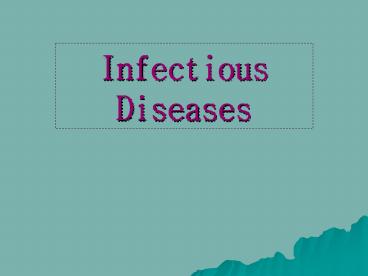Infectious Diseases PowerPoint PPT Presentation
Title: Infectious Diseases
1
Infectious Diseases
2
What is an infectious disease?
- Infection in one person can be transmitted to
others
3
Causes of re-emerging of the problem of the
infectious diseases
Infectious Diseases
- Loss of Antibiotic Effectiveness
- Increased Population Density
- Travel
- Global Warming
- Complacency and Ignorance
4
Microbiological Classification of Infectious
Diseases
Bacterial Gram-negative Gram-positive
Viral DNA virus RNA virus Enveloped vs non-enveloped
Fungal Disseminated Localized
Parasitic Protozoa Helminths
5
Means of Transmission of Infectious Diseases
Contact Requires direct or indirect contact (vomit, blood, or body fluid)
Food or Water Ingestion of contaminated food or water
Airborne Inhalation of contaminated air
Vector-borne Dependent on biology of vector as well as infectivity of organism
Perinatal Sexual Similar to contact infection, however, the contact may occur in utero or during delivery. transmission by sexual intercourse.
6
(No Transcript)
7
Epidemiological Triangle
8
Bacterial Diseases
- Tuberculosis
- Scarlet Fever
- Tetanus
- Gonorrhea
- Diptheria
- Streptococcal Infections
- Pertussis (Whooping Cough)
- Bubonic Plague
- There are many others.
9
Viral Diseases
- Common Cold
- Influenza
- AIDS/HIV
- Herpes
- Hepatitis A, B, C
- Measles, Mumps and Rubella
- Polio
- Infectious mononucleosis
- Ebola
10
Fungal Diseases
- Candidiasis
- Athletes foot
- Jock itch
- Nail fungus
- Ringworm
- Histoplasmosis
11
Infectious Disease Simulation
Transmission
- Cases
- Index the first case identified
- Primary the case that brings the infection
into a population - Secondary infected by a primary case
- Tertiary infected by a secondary case
PowerShow.com is a leading presentation sharing website. It has millions of presentations already uploaded and available with 1,000s more being uploaded by its users every day. Whatever your area of interest, here you’ll be able to find and view presentations you’ll love and possibly download. And, best of all, it is completely free and easy to use.
You might even have a presentation you’d like to share with others. If so, just upload it to PowerShow.com. We’ll convert it to an HTML5 slideshow that includes all the media types you’ve already added: audio, video, music, pictures, animations and transition effects. Then you can share it with your target audience as well as PowerShow.com’s millions of monthly visitors. And, again, it’s all free.
About the Developers
PowerShow.com is brought to you by CrystalGraphics, the award-winning developer and market-leading publisher of rich-media enhancement products for presentations. Our product offerings include millions of PowerPoint templates, diagrams, animated 3D characters and more.

